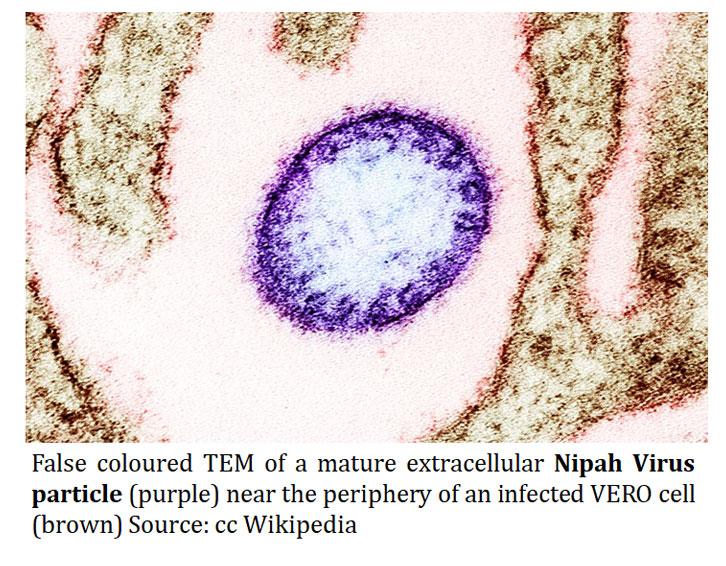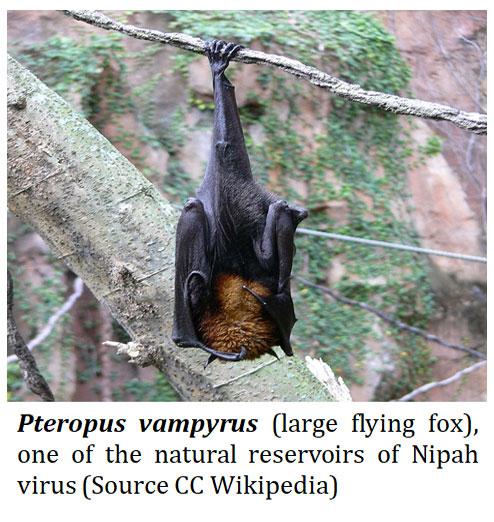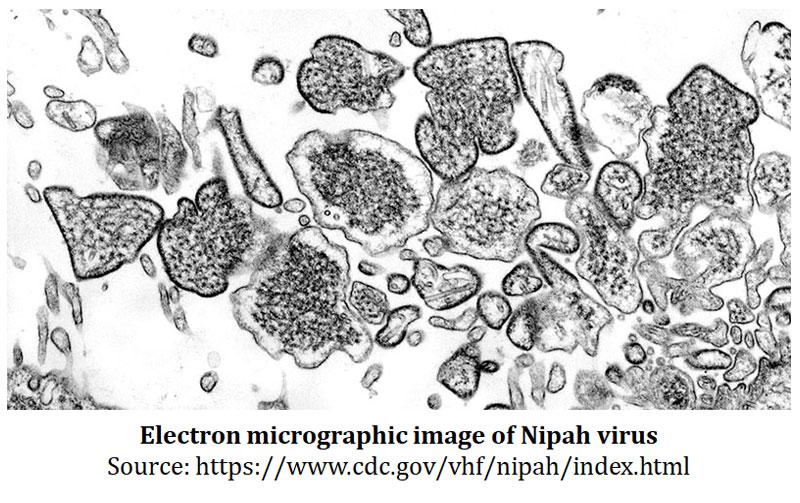Nipah Virus: An Emerging Threat to Global Health: Nipah virus (NiV) is a zoonotic pathogen that has caused outbreaks in several Asian countries primarily in Bangladesh, Malaysia, India, and Singapore. Nipah virus belongs to the genus Henipavirus. The virus was named after the Malaysian village where it was first identified in 1999. With its high mortality rate and potential for human-to-human transmission, Nipah virus poses a significant threat to public health. In this article we will explore the Nipah virus in detail, covering its history, epidemiology, transmission, clinical manifestations, diagnosis, prevention, and potential future challenges.
Microbiology Notes | Microbiology PPTs | Microbiology MCQs
Discovery of Nipah Virus
Ø Discovery of the Nipah virus is linked to an outbreak of encephalitis in Malaysia that primarily affected pig farmers in 1999.
Ø The virus was initially misidentified as Japanese encephalitis, leading to panic and a significant economic impact on Malaysian pork industry.
Ø The causative agent was later identified as a novel virus and named as Nipah.

Epidemiology
Ø Nipah virus outbreaks have primarily occurred in Southeast Asia, with sporadic cases reported in other regions.
Ø The virus is often associated with fruit bats (Pteropus species.).
Ø Fruit bats serve as the natural reservoir hosts.

Ø The infection often spreads from bats to humans via intermediary hosts, such as pigs or date palm sap contaminated with bat excretions.
Ø Several outbreaks have been reported in Bangladesh, where human-to-human transmission plays a significant role in virus spread.
Ø Additionally, India and Singapore have experienced isolated cases and outbreaks, often linked to travel from affected areas.

Virology
Ø Nipah is an enveloped RNA virus.
Ø Detailed structural features of Nipah Virus is described here…
Nipah Virus: An Emerging Threat to Global Health
Transmission
Ø Nipah virus transmission occurs through close contact with infected animals or human-to-human contact. Key transmission routes are:
(a). Bat-to-Human Transmission
Ø Direct exposure to saliva, urine, or faeces of infected fruit bats, or consumption of fruits partially eaten by bats.
(b). Pig-to-Human Transmission
Ø Pigs can become infected after consuming contaminated food or water.
Ø Human infections occur through close contact with infected pigs.
(c). Human-to-Human Transmission
Ø Nipah virus has the potential for human-to-human transmission.
Ø This can occur primarily in healthcare settings or among close contacts of infected individuals.
Ø Respiratory secretions and body fluids of infected individuals pose the highest risk.
Clinical Manifestations
Ø Nipah virus infection can lead to a spectrum of clinical manifestations.
Ø Symptoms range from asymptomatic or mild febrile illness to severe encephalitis.
Ø In severe case death can happen.
Ø Incubation period typically ranges from 4 to 14 days.
Ø Common symptoms include fever, headache, muscle pain, vomiting, and respiratory distress.
Ø Severe cases progress to encephalitis, characterized by altered consciousness, seizures, and neurological deficits.
Ø Respiratory involvement can lead to acute respiratory distress syndrome (ARDS).
Ø The case fatality rate varies between outbreaks but can exceed 70% in some instances.
Ø This makes Nipah virus one of the deadliest zoonotic viruses.
Diagnosis
The diagnosis of Nipah virus infection can be done by several laboratory methods such as:
(1). Polymerase Chain Reaction (PCR): Detects viral RNA in clinical specimens.
(2). Virus Isolation: Attempts to culture the virus from patient samples.
(3). Serological Tests: Detect antibodies against the virus in serum samples.
Ø Early and accurate diagnosis is crucial for patient management
Ø Early diagnosis also helps in outbreak control, and implementing preventive measures.
Prevention and Control
Preventing Nipah virus outbreaks and transmission is challenging but essential. Key strategies of prevention and control include:
(1). Surveillance
Ø Monitoring bat populations, livestock, and humans in endemic areas to detect and respond to outbreaks promptly.
(2). Personal Protective Equipment (PPE)
Ø Healthcare workers should use appropriate PPE to reduce the risk of nosocomial transmission.
(3). Quarantine and Isolation
Ø Isolating infected individuals and implementing strict infection control measures can prevent human-to-human transmission.
(4). Vaccination
Ø While there is no licensed vaccine for Nipah virus in humans, research is ongoing to develop preventive measures.
(5). Public Awareness
Ø Educating communities in endemic regions about the risks associated with bat and pig exposure is vital.
Challenges and Future Considerations
The Nipah virus presents several challenges and considerations for global health:
(1). Emerging Threat
Ø Nipah virus continues to emerge in new regions, indicating the potential for further spread.
(2). Limited Treatment Options
Ø There is no specific antiviral treatment for Nipah virus, and supportive care remains the mainstay of management.
(3). One Health Approach
Ø Addressing Nipah virus requires a One Health approach, involving cooperation between human and animal health sectors to monitor and control the virus.
(4). Research and Vaccine Development
Ø Ongoing research is essential for understanding the virus and developing effective vaccines and therapies.
To summarize, the Nipah virus represents a global health challenge. With its high mortality rate, potential for human-to-human transmission, and ability to emerge in new regions, Nipah virus outbreaks demand rapid and coordinated responses. Public health efforts must focus on surveillance, prevention, and research to mitigate the impact of this deadly pathogen and protect vulnerable populations worldwide.
Back to Microbiology Notes Page
| You may also like NOTES in... | ||
|---|---|---|
| BOTANY | BIOCHEMISTRY | MOL. BIOLOGY |
| ZOOLOGY | MICROBIOLOGY | BIOSTATISTICS |
| ECOLOGY | IMMUNOLOGY | BIOTECHNOLOGY |
| GENETICS | EMBRYOLOGY | PHYSIOLOGY |
| EVOLUTION | BIOPHYSICS | BIOINFORMATICS |
| You may also like... | ||
|---|---|---|
| NOTES | QUESTION BANK | COMPETITIVE EXAMS. |
| PPTs | UNIVERSITY EXAMS | DIFFERENCE BETWEEN.. |
| MCQs | PLUS ONE BIOLOGY | NEWS & JOBS |
| MOCK TESTS | PLUS TWO BIOLOGY | PRACTICAL |
